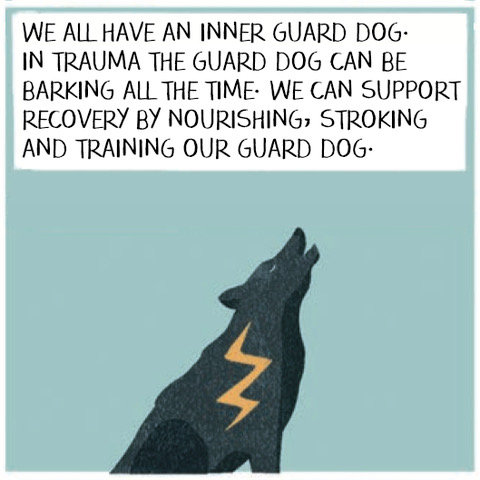When people think of trauma, they often think of psychological problems. The radical shift we’ve made through studying trauma is understanding that trauma is primarily about physiology. When we experience trauma, we get stuck in protective reflexes – gestures of survival – such as speeding up to survive (fight or flight) or collapsing / shutting down to survive.
If we can reboot the body, and come out of these stuck reflexes we become much happier and healthier, and our emotions and thoughts are quite different. By changing our physiology we can think more clearly, emote more clearly and remember more clearly.
In other words, when we experience trauma, it’s a bit like our inner guard dog – our threat detection system – either barks all the time, or collapses, withdraws and doesn’t do anything.
In this blog, I’ll share ways to work with connection to your body and other resources to train your guard dog to work differently.
One: Connect with your body
It’s important to practice being with intense feelings in safe times. You can negotiate, practice and learn how to get better at feeling your body, and how to turn down the volume on intense feelings.
It can be useful to have a guide to help you do that, such as yoga or chi gung. Here are some simple actions you can take to cultivate more connection with your body:
– Take a moment to pause, breathe, soften muscles.
– Lie on your back, let your shoulders sink into the floor.
– Feel your breath. Feel the weight of your body on the floor.
– Wiggle your fingers and wiggle your toes. Connect all the way down to your feet, and all the way out to your fingers.
– Feel the size and shape of your body.
Two: Talk with friends
Interacting with other people can feel like a ‘life or death’ act. The literature on trauma is very clear that our social status and how we interact with other people is deeply important. Most trauma is actually born from human beings or power structures abusing the power they have over people.
Our interactions with other people are fundamental to our survival. It’s not casual, it’s actually life or death, particularly when you’re interacting with someone who has power over you, or you’re at work. Our status or acceptance from our family, our social group and the people we have to work with to survive is really important.
Many of us grew up in unsafe environments, and it’s that which triggers our defense cascades. It’s important to remember that everybody gets triggered in this way sometimes. Everybody has responses to people who have power or are potentially threatening.
That’s why it’s good to talk with your friends – people you feel safe with – to share what is triggering you, and try to work it out together and practise how to respond.
Three: Grounding
Gestures of grounding are really important. It can be as simple as this: pick something you can see in the room and look at it, register that you’re safe and that you know where you are.
This can help you to respond from the present moment when you feel triggered, rather than from past experiences. For example, it can help you remember that your boss isn’t your Dad, or the person who attacked you.
Being able to make those differentiations and respond to the situation that is actually facing you in the present moment is an important way to nourish and train your inner guard dog.
Four: Practice therapeutic tremors
Most people think that shaking is a bad thing. However, when we bring a quality of curiosity and playfulness, we realise that we can have therapeutic tremors, which can be an enormous agent for change in the body.
Trauma Releasing Exercises (TRE) – a model developed by David Berceli, which emerged from the bio-energetics tradition, uses shaking as a novel stimulus to bring ease, connection and safety to a stuck organism.
We have these old reflexes inside us – if you put your body under a little bit of stress by standing on one leg, you’d wobble and shake, and that’s normal and natural. Shaking is a fundamental feature of how the nervous system controls muscles.
We have central pattern governors – oscillatory neurons in the spinal cord. What we do in TRE is to put those into a positive feedback loop. We get people shaking in safe, easy positions and the involuntary tremors move through the body, releasing tension and generating safe feelings of connection and ease which soothe the inner guard dog.
In this video I share more about TRE and how to get started with therapeutic tremors in a safe way.
Want to learn a simple, self-help tool for tension and trauma?
Try TRE, 5 Jul, 30 Jul, 23 Aug, 30 Sep 2021 TRE Intro Days Online
TRE Certification Training Module 1 Online: 21-22 Sep 2021
The Power of Touch – free, live panel discussion
On 8th July, I’m part of a live panel discussion for bodyworkers and yoga therapists about the power of touch, exploring the role of touch as part of rehabilitation, the difference between slow and fast touch, how touch can affect our emotional awareness, and more. You can register here.


